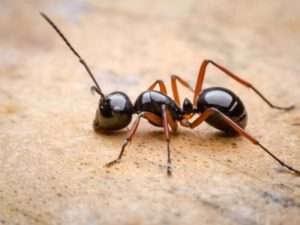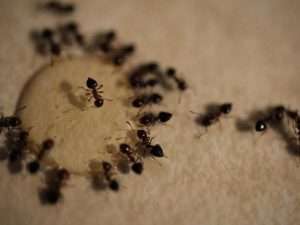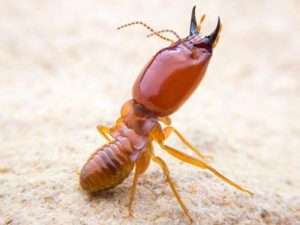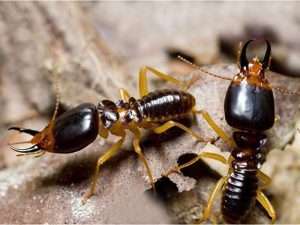Ants and termites are social insects that live together in cooperative, intermingling colonies. The colonies may range in size from hundreds to millions of members, depending on the species. Within each colony are different types of individuals, each with a specific function. All ant colonies contain one or more queens whose primary role is to lay eggs. The eggs hatch into white, grub-like larvae that later transform into adult ‘worker’ ants. The workers feed and care for the queens and developing brood, and are the ones seen foraging for food and water, often at considerable distance from the colony. Ants lay down invisible odor trails, which the workers follow between food and the nest. In many cases, the trail of ants is distinct enough to be followed back to the nesting location, or to where the ants are entering from outdoors.


At certain times of the year, ant and termites colonies produce large numbers of winged individuals known as ‘swarmer’s.’ These winged ants emerge from the nest to mate and establish new colonies. When a swarm of ants emerges indoors, it’s an indication that a nest is present. Fortunately, the likelihood of swarmer’s establishing a new colony inside a building is low. Nonetheless, an exodus of winged ants appearing indoors can be disturbing, and is often mistaken for termites.
Winged ants can be distinguished from termites by comparing certain features. Ants have a narrow (pinched) waist similar to wasps, whereas termites are virtually the same width from end to end. Ants and termites each have four wings; however, on ants the front wings are longer than the hind wings while on termites all four wings are of equal size and length. Finally, the antennae of ants are bent or “elbowed” whereas termite antennae are straight.
Ants build their nests in many different locations both inside and outside of buildings. Species nesting inside, or foraging indoors for food or moisture, tend to be the most challenging to control.
Ant & Termite Elimination
The mistake most people make when attempting to control ants is only spraying the ones they see. This approach usually fails because the ants seen foraging over exposed surfaces is only a small portion of the colony. Typically, there will be thousands of additional ants (including one or more egg-laying queens) hidden somewhere in a nest. Eliminating queens and other colony members within nests is often the key to effective ant control.
Ants Nesting Indoors. Buildings contain many favorable nesting locations for ants. Preferred sites include spaces behind walls, cabinets, and appliances; behind door and window frames; and under floors and concrete slabs. Most of these nesting areas are hidden, making it hard to pinpoint their location. When the whereabouts of a nest can’t be determined, or is inaccessible, insecticide baits are usually a good option, especially for householders.


Ant baits contain a food attractant combined with a slow-acting insecticide. Upon discovery, foraging ants transport the bait back to the nest and feed it to the queen(s) and other colony members. As a result, the entire colony can be destroyed. Several effective ant baits are sold in stores and online. Some come in pre-filled plastic stations (about the size of a cookie), while others come in a plastic tube or syringe. Often formulated as gels, the squeezable/syringe-type baits are often the most versatile and effective. Popular consumer brands include Saso, Raid, Fatala and others. Highly effective professional ant baits sold online include Geotox, Foval Gel, Fly Cip or Foval CE. Active ingredients in such baits include fipronil, imidacloprid, indoxacarb, thiamethoxam, and dinotefuran.
Place the baits next to wherever ants are seen, preferably beside ant ‘trails’ —invisible odor trails that worker ants follow between food and the nest. When using gel-type baits, floors, countertops and other indoor surfaces can be protected by placing dabs of bait on the top (non-sticky side) of masking tape, wax paper, etc. As a convenience, some baits also come with small plastic trays. Do not spray other insecticides or cleaning agents around the bait placements as this may deter ants from approaching and eating the bait. Initially, you should see an increase in the number of ants around the bait… DO NOT SPRAY THEM. This indicates that the ants are feeding and transporting the material back to the nest. Ant activity will usually subside in a few days as the number of ants in the colony declines. Continue to place additional baits wherever ants are seen.
Ants are rather finicky in their food preferences and may alter them throughout the year. If one bait product isn’t attractive or doesn’t seem to be working, try another. Optimal results usually require a sustained period of feeding, not just a brief visit by a few ants.
Ants Nesting Outdoors. Ants noticed indoors are often originating outside. Try to trace the ants spotted inside back to the point where they are entering from outdoors. This may be beneath an entrance door, along a window sill, or where exterior siding meets the foundation wall. Ants usually prefer to trail along lines and edges. When tracing ant trails indoors or outdoors, pay attention to cracks, seams, and edges created by baseboards, the tack strip beneath perimeter edges of carpeting, mortar joints, the foundation-siding interface, etc. Nests sometimes will be located in the ground, marked by a mound or anthill; other times, the colony or colonies will be concealed under mulch, gravel, stones, landscaping timbers, pavement, or beneath the grass edge abutting the foundation of the building. Some kinds of ants prefer to nest behind exterior siding or wood trim that has been damaged by moisture. While it takes a bit more time to locate where ants are entering from outdoors, results will be more rapid and permanent than if you only treat ants which have already entered. One way to entice ants to reveal the location of their hidden trails and nests (outdoors or indoors), is to place small dabs of honey or jelly on an index card, etc., next to where ants are observed. After the ants have fed, they will head back to the nest.